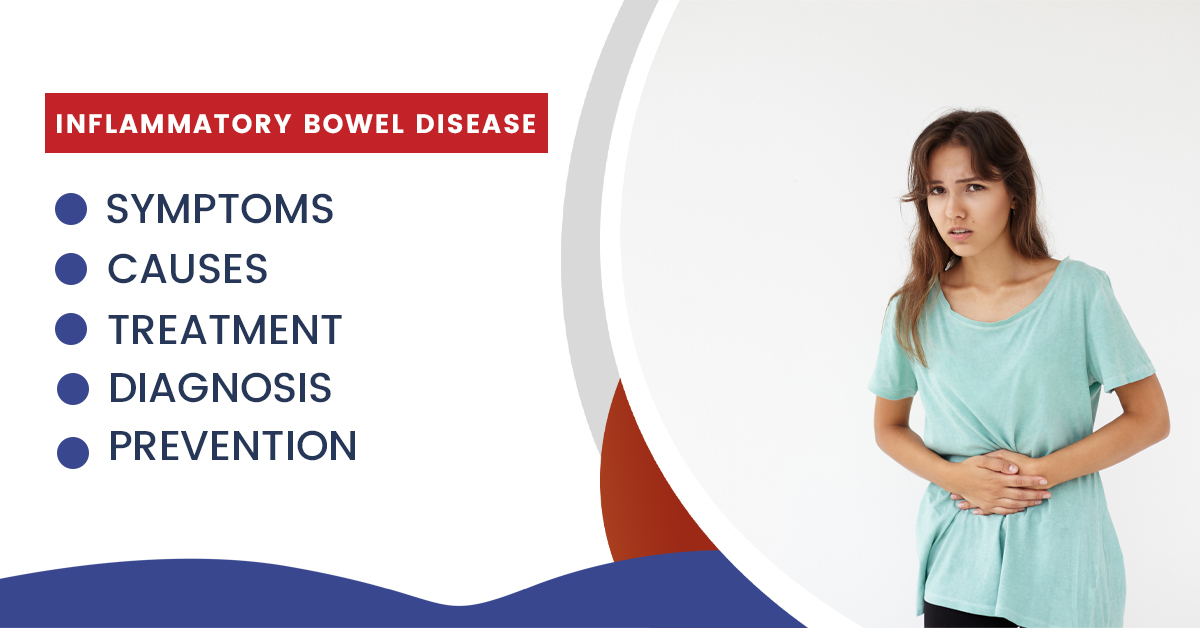What is Inflammatory Bowel Disease (IBD)?
A series of illnesses known together as inflammatory bowel disease (IBD) results in persistent inflammation (pain and swelling) in the intestines. IBD encompasses ulcerative colitis and Crohn’s disease. The digestive system is affected by both types of IBD. Some treatments can be used to treat this chronic illness.
Types of Inflammatory Bowel Disease (IBD)
- Ulcerative colitis. Symptoms include inflammation and sores in the lining of the large intestine (colon) and rectum (ulcers).
- Crohn’s disease. This type of IBD can cause inflammation of the stomach lining, which can often affect the deeper layers. The small intestine is the most common site of Crohn’s disease. The large intestine, however, tends to be less affected by this disease.
Symptoms of IBD:
It is important to note that inflammatory bowel disease symptoms vary according to the location and level of inflammation. Mild to severe symptoms are possible. Intervals of remission generally follow periods of active sickness.The following symptoms and signs are common to both Crohn’s disease and ulcerative colitis:
- Diarrhea
- Fatigue
- Abdominal pain and cramping
- Blood in your stool
- Reduced appetite
- Unintended weight loss
Rarely, IBD may also cause:
- Itchy, red, painful eyes.
- Joint pain.
- Nausea and vomiting.
- Skin rashes and sores (ulcers).
- Vision problems
Causes of IBD:
IBD’s precise cause is not known. However, several things can make you more likely to get Crohn’s and UC.
Family history and genetics
People are substantially more likely to contract IBD if they have a parent, sibling, or kid who has it.
The immune system
IBD could be impacted by the immune system as well. Normally, the immune system protects the body from pathogens—organisms that cause infections and disorders.
An immunological response may be induced by a bacterial or viral infection of the digestive tract. As the body tries to mount an immunological defence against the invaders, the digestive system swells up in inflammation.
Smoking
It is well known that smoking is a major risk factor for developing Crohn’s disease. The pain and other symptoms of Crohn’s disease are also exacerbated by smoking. However, nonsmokers and former smokers are the primary victims of UC.
Age
IBD can occur at any age however, it typically manifests before the age of 35.
Environmental factors
Urban dwellers and citizens of industrialised nations are more likely to acquire IBD. IBD is more prevalent among people who live in northern climes, where it is frequently chilly. Residents of industrialised countries also end to eat more fat and processed food, which is linked to the development of IBD, even in geographical regions around the world.
Gender
IBD often has an equal impact on males and women. A study found that UC is typically more prevalent in men over 45 than it is in women in the same age range. On the other hand, women above the age of 14 and girls are more likely to get Crohn’s disease.
Diagnosis of IBD:
The medical history may raise a suspicion of IBD, but the results of diagnostic tests will ultimately determine the diagnosis. The examination may involve:
Inflammatory bowel disease is diagnosed by your doctor based on your symptoms and the results of several examinations and tests:
- Stool exam. To rule out the potential bacterial, viral, or parasite causes of diarrhoea, you will be requested to provide a stool sample that will be sent to a laboratory. Further testing will be done on the faeces to look for undetectable blood traces.
- Complete blood count. You will be asked to produce a stool sample that will be sent to a lab to rule out the possibility of bacterial, viral, or parasitic causes of diarrhoea. The faeces will undergo additional testing to seek for undetectable blood traces.
- Other blood tests. To determine the severity of the illness, blood samples may be taken for electrolytes (sodium, potassium), protein, and inflammation markers such as erythrocyte sedimentation rate (ESR) and C-reactive protein (CRP). Levels of pANCA, or perinuclear antineutrophil cytoplasmic antibody, may be higher in ulcerative colitis. Additionally, specialised tests for STDs might be performed.
- Barium X-ray. It can examine the oesophagus, stomach, and small intestine for abnormalities brought on by Crohn’s disease, despite its infrequent use. You ingest a white, chalky solution that coats the digestive tract and makes it radiopaque so it can be seen on X-rays. If a barium study is required to examine the lower GI tract, you will be given a barium-containing enema and instructed to hold it in while rectum and colon X-rays are obtained. These X-rays may reveal abnormalities brought on by either Crohn’s disease or ulcerative colitis.
- Other radiologic tests. Crohn’s disease and ulcerative colitis can also be diagnosed using ultrasound, magnetic resonance imaging (MRI), and computed tomography (CT scan).
- The last third of your large intestine, which includes the rectum and the sigmoid colon, is visually examined during this procedure using a sigmoidoscope, a small, flexible tube with a camera and light. Through the anus, a sigmoidoscope is introduced to visually inspect the intestinal wall for ulcers, inflammation, and bleeding. The medical professional may also use a tool put into the tube to take biopsies, or samples, of the intestinal lining. These will subsequently be inspected under a microscope in a lab setting.
- A colonoscopy is identical to a sigmoidoscopy, with the exception that the doctor will look at the entire colon using a colonoscope, a longer flexible tube. You can use this approach to determine the severity of the colon ailment.
- Upper endoscopy. A doctor will use an endoscope, a thin, flexible tube with a camera and light that is put through the mouth, if you have upper gastrointestinal symptoms like nausea and vomiting, to inspect your oesophagus, stomach, and duodenum, which is the first section of your small intestine. Up to one in ten persons with Crohn’s disease develop ulcers in the stomach and duodenum.
- Capsule endoscopy. For example, Crohn’s disease, which affects the small intestine, may be diagnosed using this test. You ingest a little capsule with a camera inside of it. The oesophagus, stomach, and small bowel are photographed, and the images are relayed to a receiver that you wear on your belt. The photographs are downloaded from the receiver onto a computer after the process. Your body is used to insert the camera into the bathroom.
Risk factors of IBD:
- Most IBD patients are discovered before they are 30. Some people, however, don’t begin to exhibit symptoms until they are in their 50s or 60s.
- ethnicity or race. IBD can affect people of any race, though it tends to affect white people more frequently. There are more cases among people of other races and nationalities as well.
- Family background. If you have a close relative who has the condition, such as a parent, brother, or kid, your risk increases.
- using cigarettes. Cigarette smoking is the biggest important avoidable risk factor for Crohn’s disease.
- Using tobacco may help stave against ulcerative colitis. Smoking has more negative effects on your health than positive ones, and quitting can help your digestive tract in general as well as many other health benefits.
- drugs that are nonsteroidal anti-inflammatory. These include diclofenac sodium, naproxen sodium (Aleve), and ibuprofen (Advil, Motrin IB, among others). These drugs could make IBD worse for those who already have it or raise the risk of getting it.
What are the complications of inflammatory bowel disease (IBD)?
Colon (colorectal) cancer is more likely to strike IBD patients. Other potential problems include:
- bowel cancer Your chance of developing colon cancer may increase if you have Crohn’s disease or ulcerative colitis that mostly affects your colon. After the original diagnosis, the first colonoscopy for cancer screening often occurs 8 to 10 years later. Ask your doctor how frequently and when you should have this test performed.
- swelling of the eyes, skin, and joints A range of illnesses, including arthritis, skin rashes, and eye irritation, can be triggered by IBD flare-ups (uveitis).
- adverse effects of medication. Some IBD medications carry a risk of infections. Some people have a slender probability of developing specific cancers. A higher prevalence of osteoporosis has been associated with corticosteroids.
- primary sclerosing cholangitis The bile ducts scar in this relatively uncommon condition as a result of IBD patients’ inflammation. This scarring causes the ducts to gradually shrink, which reduces bile flow. The liver may suffer as a result of this.
clots in the blood In persons with IBD, blood clots in the veins and arteries are more likely. - Dehydration can arise from persistent diarrhoea.
- intestinal obstruction The severity of the intestinal wall is impacted by Crohn’s disease. The gradual thickening and constriction of some colon segments may block the movement of digestive materials. Your intestinal segment that is impacted can require surgical removal.
- You may find it challenging to eat or for your intestine to absorb enough nutrients to keep you nourished if you have diarrhoea, abdominal pain, or cramping. Low iron or vitamin B-12 levels associated with the illness are also frequently responsible for anaemia.
- A fistula is an unusual connection between several bodily organs that can occur when inflammation completely penetrates the intestinal wall. The most typical type of fistula is perifanal, located close to or around the anal area. However, they can also develop internally or in the direction of the abdominal wall. A fistula can occasionally develop into an abscess, which is a pus-filled pocket that is infectious.
- Anal fracture. Here, there is a little tear in the skin or surrounding tissue, which could get infected. It often leads to uneasy bowel motions and may result in a perianal fistula.
Treatment of IBD:
Non-Surgical Treatment:
Treatments for IBD differ depending on the specific kind and symptoms. Drugs can reduce inflammation so you don’t experience symptoms (remission). IBD medications include the following:
- Sulfasalazine, mesalamine, and balsalazide are examples of the anti-inflammatory medication class known as aminosalicylates that also decrease intestinal discomfort.
- Abscesses and infections are treated with antibiotics.
- Biologics block inflammatory signals from the immune system.
- Among the most commonly prescribed corticosteroids, prednisone regulates the immune system and controls flare-ups.
- Immunomodulators reduce immune system overactivity.
- anti-diarrheal drugs.
- medications that are non-steroidal anti-inflammatory (NSAIDs).
- products like probiotics and vitamins.
Surgical Treatment:
Your doctor might advise surgery if diet and lifestyle modifications, medication therapy, or other treatments are ineffective at treating your IBD symptoms.
- Surgery for ulcerative colitis. The whole colon and rectum are removed during surgery, and an internal pouch connected to the anus is created to enable bowel movements without a bag.
A pouch may not always be feasible. Instead, a permanent hole (ileal stoma) is made in your belly by the surgeons, through which stool is passed and collected in a bag attached to the hole. - Surgery for Crohn’s disease. Most Crohn’s disease patients will require at least one surgery throughout their lifetime—up to two-thirds. Surgery cannot treat Crohn’s disease.
During surgery, the damaged portion of your digestive tract is removed, and the healthy segments are then reconnected. Surgery may also be used to close fistulas and drain abscesses.
The benefits of surgery for Crohn’s disease are often very temporary. Near the reunited tissue, the disease often returns. It is advised to take the medicine after surgery to lower the risk of recurrence.





















 Disclaimer: The information on the Web Site is provided for informational purposes only and is not meant to substitute the advice provided by our doctor or other health care professional. You should not use the information available on or through the Web Site for treating a health problem or disease or prescribing any medication. All images used on this website are for illustrative purposes only,
Disclaimer: The information on the Web Site is provided for informational purposes only and is not meant to substitute the advice provided by our doctor or other health care professional. You should not use the information available on or through the Web Site for treating a health problem or disease or prescribing any medication. All images used on this website are for illustrative purposes only,